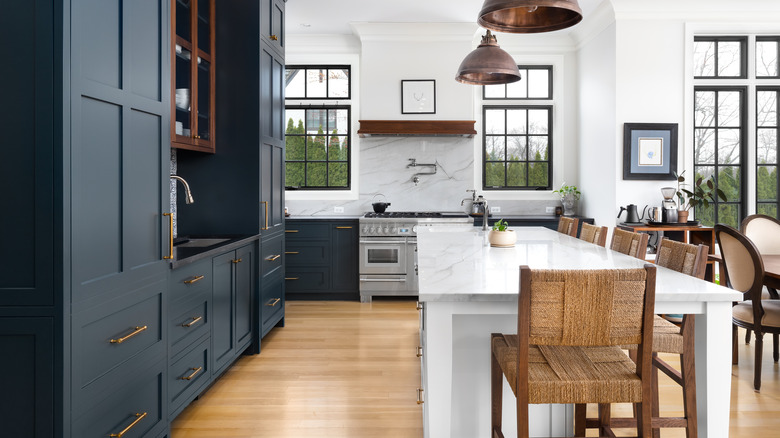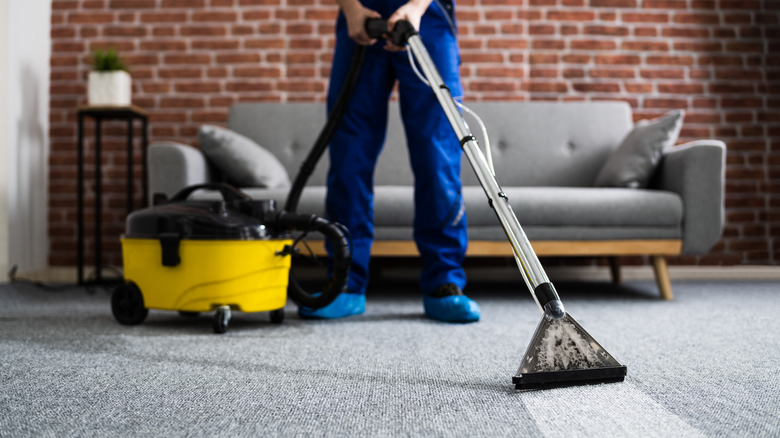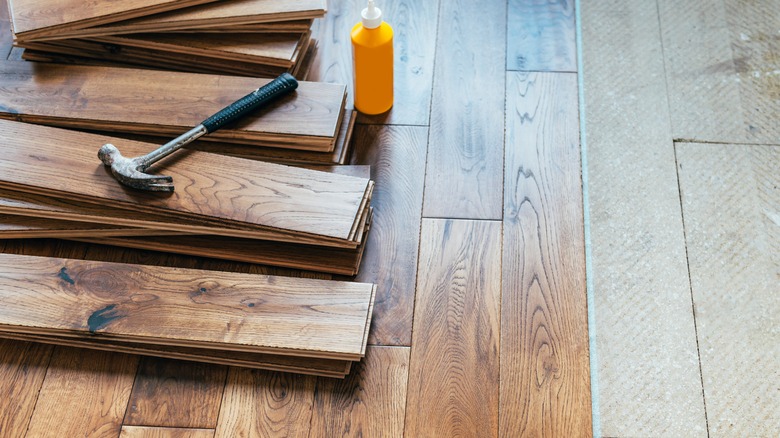Carpet Vs. Hardwood: Which Type Of Flooring Is Right For You?
Choosing a suitable floor covering is probably one of the most important home decor decisions, as it provides a foundation for the kind of interior design style you're going for. There are several factors that can impact this decision, from how much traffic the room receives to how much money you intend to spend.
Tile or stone floors can be inexpensive with lots of unique designs, but they can get very cold in the winter. Concrete and vinyl are also straightforward options that get the job done but they often need extra rugs or mats to feel comfortable. Alternatively, carpet and hardwood flooring are two of the most popular options because, as Giant Floor explains, they can make a home feel luxurious, warm, and cozy. Carpets can last up to ten years with the right care before they need to be switched out, while hardwood floors can last much longer if properly maintained.
How does the composition differ?
Hardwood floors can either be made of solid planks or engineered from multiple layers of wood. These floors can also be pre-finished or unfinished, which means the final, protective top layer is applied after it is installed. HGTV estimates that over 60% of hardwood flooring in the U.S. is made with oak, but there are many other choices of wood depending on the look you are trying to achieve. Bamboo, maple, and cork have light earthy tones, whereas mahogany and teak tend to have a much darker finish.
The majority of the carpets available nowadays are composed of synthetic fibers that are tightly looped together, which makes them highly durable, notes The Spruce. Some carpets are made from natural fibers, such as wool and cotton, and these provide a comfortable, soft surface for bare feet. Most carpet styles are available in a range of colors and patterns, making it easy to choose one that matches your furniture and decorations.
Pros and cons of carpet
If you are conscious of costs, carpet flooring is significantly less expensive than hardwood, costing, on average, around $3.50 to $11 per square foot to install, notes HomeAdvisor. Carpeted floors reduce the noise of walking and other movements, and if you have young children, carpet is a somewhat safer option because it can soften a fall. In addition, carpet flooring is a good choice if you live in a cold area, as it helps to keep in the warmth. What's more, when you reach a point that it needs to be replaced, it is a fairly easy process to take it out, according to This Old House.
On the other hand, carpets require a certain amount of maintenance. They need regular vacuuming and stain removal treatments, and it's not easy to hide when a carpet is worn out, explains My Tidy Corner. Additionally, due to the tightly-woven material a carpet is made with, it can also harbor a lot of germs, dust, and allergens, notes My Tidy Corner.
Pros and cons of hardwood
Hardwood comes in many varieties, allowing it to be tailored to your specific style. It can be installed in any room, which is convenient since it brings cohesion to a home. It also adds to the value of your home as it is one of the things that buyers look for when searching for a new property, suggests Clever. In terms of cleanliness and maintenance, hardwood makes it easier for you to clean up after your little ones or your pets.
Something to watch out for, though, is that solid hardwood is sensitive to elements like humidity and moisture, making it a poor choice for kitchens or bathrooms. Because of its appearance, quality, and durability, hardwood flooring is also on the more expensive side. According to Bob Vila, it can cost between $6,000 and $12,000 to install 1000 square feet. One handy tip to save on the cost of hardwood is to buy reclaimed flooring that has been salvaged from another home, recommends HGTV.
Durability and maintenance
With the proper care and maintenance, hardwood flooring is an investment that can be protected. Ad It Yourself explains that a consistent cleaning routine should involve daily sweeping, mopping, and clearing off any dirt. You should also make sure you're using the right cleaning products, as many contain unsuitable chemicals and ingredients that can cause damage in the long term.
The Spruce notes that you should be vacuuming your carpets once a week at the minimum, and more if your carpet is getting a lot of use. Vacuum on a high suction setting and treat stains as soon as possible by blotting liquids and lifting solids. My Fair Cleaning suggests moving your furniture around regularly in order to even out the parts of the carpet that are being used and exposed. Keeping the living area free from shoes and having curtains and shades to protect the carpet from direct sunlight are also ways to preserve its quality.




